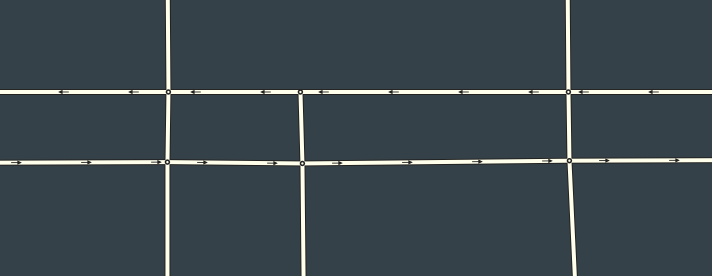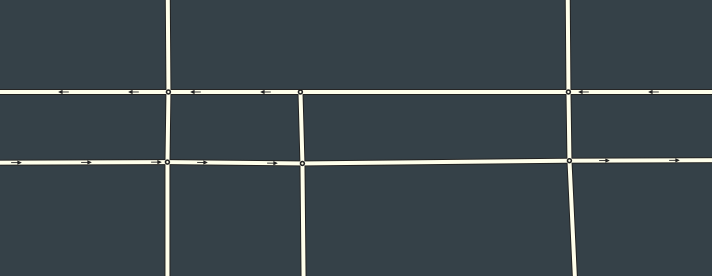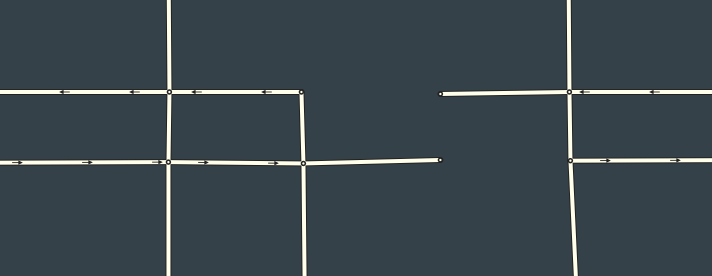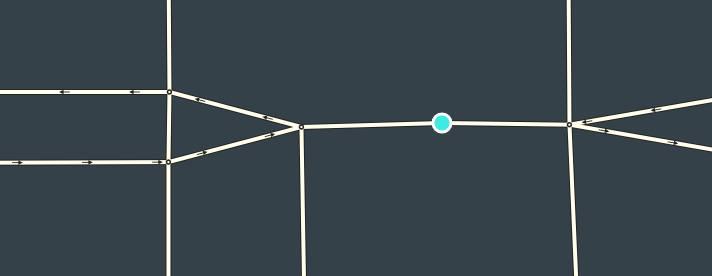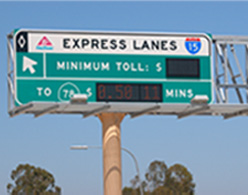m (Updated Pictures for perpendicular and angled per forum discussion) |
|||
| Line 264: | Line 264: | ||
| [[File:Perpendicular Parking Lot Parking.PNG]] | | [[File:Perpendicular Parking Lot Parking.PNG]] | ||
|- | |- | ||
| PLR aisles with perpendicular parking (u-turn | | PLR aisles with perpendicular parking (u-turn on ends of green star segments) | ||
|- | |- | ||
| [[File:Angular Parking.png]] | | [[File:Angular Parking.png]] | ||
Revision as of 02:56, 28 October 2020
| This new page is currently undergoing modifications. The information presented should be considered a draft, not yet ready for use. This content is open to changes from anyone during construction. If you would like to make changes or have questions, please post a message in this forum. |
The purpose of this page is to help all map editors design maps that work best for the end-user--the driving public--while minimizing the amount of (re)work you have to do because of common mistakes or subtle limitations of the tools. For those who are an Area Manager, many helpful pages already exist on your responsibilities, including how to use Waze Map Editor, identify and solve Map problems and Update Requests, set standards for labeling roads, and a general Frequently Asked Questions (FAQ). These same sources are incredibly useful for newer editors as well and should be reviewed to become familiar with the various elements of Waze map editing before getting too deep with your edits.
If you find something missing from this page or any page of the Wiki, either be bold and edit the page to add or modify the information (if you are confident that is how it works), or you can post a comment in the Wiki improvement forum.
| Some of the guidance for Best map editing practice may have specific localized adjustments for your local area. Be sure to familiarize yourself with these differences through the Local vs national guidance page. |
Overall Goals
Usability
When it comes to the map, the first and foremost goal of editing is to provide the driver with a map that is easy to follow on a small display and to produce sensible verbal instructions when (and only when) they are needed.
Simplicity
It is not a goal to model the physical roadway lane-by-lane. Doing so often leads to unnecessary complexity--which means a cluttered map, confusing verbal directions, and lots and lots (and lots!) of extra map maintenance.
Retention
Because Waze users drive over them, road segments retain certain information (e.g., average speed) that is used in route optimization. When a segment is deleted, the information in the segment is discarded. Given a choice between deleting a tangle of segments and creating new ones in their place, vs. untangling them and reusing them, it is better to "recycle".
In Practice
Dividing and un-dividing divided highways
When to divide a two-way road (and when not to)
Generally, a road should be un-divided unless it meets any of the requirements for dividing a road. When initially reviewing whether to divide or "un-divide" (merge back together) a roadway, consider these points first:
- The default representation for any roadway is a single 2-way segment, even if the physical roadway is divided. Dividing a roadway carries with it the burden of proof that the change will improve the usability and/ or simplicity of the Waze map.
- If a road is currently working with no problem reports, consider leaving it as is.
- If the area has an Area Manager, consult with them before dividing/un-dividing. If the area does not have an Area Manager and after reviewing the formal guidelines below you are unsure which way to go, consider sending a permalink of the road to the map editing forums to get additional feedback from other editors.
- Try to avoid switching roads back and forth between being divided and 2-way. For example, if most of the road is clearly divided and only parts would be considered a single two-way road, consider leaving it all divided. If only a small portion seems better off divided, consider keeping it all 2-way.
A road may be divided when any of the following conditions are met:
- It is an Interstate Highway (USA) or other Limited Access Highway using the "Freeway" road type,
- GPS tracks show a clearly definable and continuous gap (blank area) between the color-by-azimuth arrows at the 100m/500ft zoom level,
- multiple houses or businesses with no off-street parking are located directly on the street but are not accessible from the opposite direction of travel due to lengthy median, obstruction, or traffic control signage, or
- U-turns are required to properly make turns from public drivable road types that are blocked by a median.
A road should not be divided when:
- There is a curb or non-drivable median less than 5m wide between lanes of travel (see exceptions above).
- The non-drivable median is interrupted by a cross segment at most intersections.
- There is a center turn lane (any width) between directions of travel. Dividing this type of road creates problems when people turn from the middle lane because there is no road for the navigation to follow.
- It is possible and legal to make a driver side turn/u-turn everywhere along the road
- The objective is solely for visual appearance or to make the road match another visual source like Google Maps.
Remember that dividing and un-dividing roads each comes with its own set of problems. Each situation is unique and some issues may be more manageable with a single two-way road, and some may work fine with a divided road. Consider every aspect of routing, and carefully examine each junction before dividing or un-dividing. Regardless of whether you're dividing or un-dividing, remember that you might cause more problems than you solve and you might have to put it back the way it was before. Also remember that dividing and un-dividing each cause loss of some traffic data, which can result in poor Waze routing.
How to un-divide two one-way roads
Unfortunately, there is no easy way to merge two one-way roads back into a two-way road--which is why you should always give a lot of thought before dividing a road in the first place. And then think some more.
When you come across a road in your area that has been divided but shouldn't have been, you have some major map surgery ahead of you. Because of this high complexity in this process, it is recommended NOT to merge the two one-way roads UNLESS there are Update Requests related to the road caused by it being divided.
The process to un-divide a road (convert from two one-way roads to one two-way road) written below has been specifically designed to preserve the underlying address information embedded in the street segments. It is very important that you do not simply delete one of the two roads because that deletes the house address data on that part of the road. They would have to be looked up and manually added back to the new road.
The steps below show how to properly merge two one-way roads and preserve the underlying house numbers.
This is our example road segment. For the entire length of the road you need to:
1. Select the two segments to be merged and set them both to two-way.
2. Disconnect both segments from one side of the section being un-divided. It is best to disconnect alternate ends of each segment as shown.
3. Bring the two disconnected ends together in the middle (and realign the roads as necessary, removing the unnecessary segments as shown). You can remove the junction point you just created by selecting it and clicking the trash can icon or using the Delete key (Fn + Delete on Mac). Please note that the 2 aligned sections must have matching road information (name, type, direction, speed limit, elevation, and lock) or the junction point will not allow removal!
The following video was recorded by an editor merging two one-way roads so the addresses were preserved. This video follows the described steps above but may help seeing it happening in real time. Press the "enlarge button in the lower right corner to see it full screen.
{{#ev:youtube|6blRMtGwaYA}}
Un-Dividing Roads and Preserve HN - Video Reference
Un-Dividing Roads WME 2018 - Video Reference
After BOTH sides are merged into one, you need to re-align house number to the street so that it lines up with driveway/entrance of the building the bubble is over.
- With the street/road selected, click ‘Edit house numbers’.
- From the house number editing view, you need to select each house number one-by-one.
- With the house number selected, you see the dashed line is attached to a circle on the street.
- Select the circle and move it along the road closest to the entrance of the driveway to the building.
Also be sure to check the following:
- Remove all "orphaned" junctions.
- Change the direction of the preserved segments to two-way.
- Check/fix the connectivity of all the roads already connect to the side you kept.
- Connect (and set connectivity) of all the roads that used to be connected to the other side.
- Make sure all the new two-way segments are connected.
- Adjust the geometry to move the two-way road segments to the middle of the road.
Now repeat the entire process for the remaining segments matching the two opposite from each other.
It isn't difficult once you have gone through the process a couple of times.
Caveat: If you decide to be clever and edit the road properties of multiple segments at a time, first familiarize yourself with the known problems with mass-editing. It can be done -- but if you're not careful, you'll find that all the road segments have reverted to Streets...in Alabama...and any alternate road names are lost.
Highways and Ramps
Useful long-range navigation is impossible with Waze if the highways are broken. Because limited-access roads -- typically Freeways & Major Highways -- offer more to think about (and more opportunities to mess them up) than typical surface-road work, this section is very important.
Roads
The term "limited-access road" here refers to a road that is multi-laned in each direction, with a physical barrier between directions, and which can be entered and exited solely by ramps. Such roads should almost always be mapped as separate one-way segments -- and other roads should almost never be.
Ramps
As stated elsewhere, off-ramps should be named according to their exit number if they have one, as well as whatever is on the actual exit sign; e.g., "Exit 7: Rte 3 S / Braintree / Cape Cod". On-ramps should be named "to" whatever they lead to; e.g., "to I-93 S / Quincy / Providence RI". Because ramps often run especially close to other ramps that flow in the opposite direction, a ramp should be locked to preserve directionality.
Remember to check connectivity and turn restrictions while you're there.
- There is a more detailed description of How to label Exit ramps and Entrance ramps.
- Be sure to understand the difference between ramps and at-grade connectors.
Overpasses & Underpasses
Setting the road elevation can be tricky. Sometimes it is more important to know that road elevation is an issue for a particular segment (e.g., a mile-long stretch of highway that extends well beyond the screen boundaries), than what its actual value is, or of maintaining a consistent elevation across multiple segments of the same road.
Ground level should be considered as a "sentinel value" that signifies a segment has no overpasses or underpasses. When editing an over/underpass, if either segment is at ground level, set the other one to a non-zero value that reflects its relative elevation to the one marked at ground level. If both elevations are already non-zero, either they are already correct (in which case no further action is required) or they are incorrect in which case the area needs to be studied carefully so as not to "break" other intersections that have already been evaluated and assigned.
In many cases, the conflict can be resolved simply by adjusting the elevation of one segment, or perhaps of several segments. Proceed with caution. In really complicated situations, it might help to draw a picture, or to start by looking for the top-most or bottom-most segment.
Occasionally you run into a situation in which no set of values will work. For example, three segments named A, B, and C: A crosses over B, B crosses over C, and C crosses over A. So A > B > C > A... now what? Either pretend that one of the segments crosses over both of the others, or add a junction to one of the segments so that it can have two different elevations as needed and hope nobody deletes that "unnecessary" junction without investigating why it might be there. In this example it might even make sense to add junctions to all three segments, just to make it clearer to the next AM what you're trying to accomplish.
Caveat re. Elevation
No matter what elevation road segments are assigned, if you pin a junction through them, they now form a navigable intersection, and Waze will instruct people to turn off of bridges and onto the cross-streets below. If you are looking at an over/underpass, and there is a junction where the roads cross, get rid of it. First, make sure the elevations of the road segments are correct, and that all the other information of each pair of road segments match. At that point, deleting the junction will most likely work. If that does not work, refer to deleting a junction for more information.
See also Road Elevation.
Bridging Roads
Select the two segments that cross over/under the intersection, then click on the "Bridge" link. If all goes well, the selected segments will be separated from the underlying junction, consolidated into a single segment, and their elevation increased by 1. Failing that, you may have to disconnect both sides of the over/underpassing road from the junction, make sure their elevations are correct, and then re-connect them.
Handling Restricted Lanes
| There have been major changes to the way Partial restrictions are handled in the WME. The text below is out of date and should not be utilized when editing the map |
At this time, Waze does not have a facility to handle restricted lanes; e.g., high-occupancy/"carpool" lanes. This is important because these lanes sometimes have their own ramps that the regular lanes do not have, and they often run alongside the main road so that GPS has a hard time discriminating between the two. The result is driving instructions that can range from incorrect to deadly.
The most direct solution might appear to be omitting/deleting these lanes from the map. Please do not delete these lanes. As Waze implements more features, it helps (in terms of testing and making the feature available) if these lanes are already mapped.
The best partial solution the community has come up with is described in detail on the Carpool, HOV, Transit lanes page. The lanes should be set with the appropriate road type for the road they are part of, and the entrance (and in some cases exit) ramps set with the appropriate restrictions for vehicle type (and time). If the lanes are reversible then they will have to be set with separately timed restrictions for each direction on the lanes themselves as well.
This "solution" gives routing onto these special lanes a very high penalty when they are being enforced, and reduce the likelihood that Waze will create a route over them. It does not prevent Waze from snapping a driver to the segments if it determines they are on such a lane, and any recalculation of the route from these segments is correct as well. However, as noted above, the fact that these lanes are usually quite close to the normal/open freeway or highway makes it unlikely Waze will automatically recognize their true location due to GPS inaccuracy and margin of error.
- For more details on this topic, see Carpool, HOV, Transit lanes.
High Occupancy Toll (HOT) Roads/Lanes (USA)
The United States DOT has been working with local governments to introduce a new type of roadway called High Occupancy Toll (HOT) lanes/roads. In many cases, these roads replace existing HOV lanes and run in the median between different directions of non-toll traffic along a freeway.
HOT roadways have the following features:
- These lanes/roads allow both toll traffic and HOV traffic to traverse the same lanes.
- There are no toll plazas or booths for paying by cash. All tolls are paid electronically to maintain traffic speed.
- Entrances and exits to the HOT lanes are limited to help maintain high speeds.
- There are no entrance/exit combinations where the toll fare rules don't apply.
- Tolls are discounted or waived for users that meet High Occupancy Vehicle (HOV) requirements. These requirements may change based on time of day.
HOT lanes are often marketed as "Express Lanes"; however, the term "Express Lanes" is also used by various regional governments for non-HOT lanes. In order to be considered a HOT lane for Waze purposes, a road needs to meet all criteria listed above.
| There have been major changes to the way HOV lanes are handled in the WME. The text below is out of date and should not be utilized when editing the map |
The entrances to HOT lanes should be marked with the toll flag. This prevents Waze from routing those wishing to avoid tolls onto the HOT lanes, while allowing Waze to use the HOT lanes for routing for those willing to pay a toll for a faster commute.
The lanes of the HOT itself should not be flagged as a toll road, to prevent Waze from trying to route HOV users out of the HOT lanes if they have toll avoidance active in the client.
Because Waze does not currently support HOV lanes, HOV users with toll avoidance turned on are not routed onto the HOT lanes. Just as with the current HOV best practices, those that meet the HOV requirements and wish to use the HOT lanes need to navigate themselves to the HOT lanes; they are not be routed onto them by the Waze client. As with standard HOV lanes, HOV users need to recalculate the route for Waze to snap them to the HOT lane.
Because HOT lanes are still considered "experimental" there may be some variation in local implementation. If the HOT lane does not meet all the requirements listed above, check with an experienced local editor or Country Manager before making any changes. When in doubt seek advice on the forum; a change to the guidelines or an exception may need to be made for the local variation.
Toll roads
Roads with tolls can be indicated using the checkbox Toll road in the Add Restrictions menu on the road segment properties tab. Mark a segment as a toll road only if there is a toll booth, transponder reader, or other tolling device within or at either end of the segment. Do not set segments as toll roads if they are leading up to the final toll segment, even if they have no other exit except the final toll segment.
In the case of a bridge that is tolled in only one direction, divide the road where the toll is collected and mark only the segment with the toll booth as a toll road.
For more information, see the toll page.
Time Restricted Turns
The Waze Map Editor and routing engine support scheduled restrictions (time of day, day of week, turns, traffic flow direction, vehicle type, etc.).
Please see the Partial restrictions page for full documentation on this feature.
When to Use Ramps in an Intersection
Please see the discussion on at-grade connectors.
When to Create a Roundabout
In the author's editing and driving experience, once you learn how to create a roundabout, it is always the right time to replace an ad hoc traffic circle (built from regular road segments) with a proper roundabout. The voice cues produced by an ad-hoc circle can be terribly misleading, and the client display almost always looks unprofessionally sloppy. Replacing this with a roundabout is an instant, orders-of-magnitude improvement on both counts.
Note: A roundabout should never be used in place of an end-node on dead-end or cul-de-sac street. See: Junction Style Guide
Locking Segments
In some regions, there are locking rank standards applied based on road type. In these regions, all roads of a certain type are locked to a minimum rank and should be locked even in residential areas. Check your local wiki for your local standards to see if these apply in your editing area. Locking should otherwise be used on high-value roads and complicated junctions to prevent inexperienced lower rank editors from making changes.
NEVER lock a segment unless you are sure that it and everything that touches it (junctions, turn restrictions, and other segments) is 100% complete and correct.
If you run into a segment or junction that is locked by someone at a higher editing rank than you, refer to the page on unlocking an object above your rank for more information.
Locking should be used sparingly and carefully.
Junction Style Guide
When creating or editing a junction, it is very important to understand the nuances of how the Waze routing engine looks at the map segments and junctions. The Junction Style Guide provides the best practices with the many different types of junctions.
Parking Lots
| As of October 2018[update], guidance changed to recommend more detailed mapping of Parking Lot roads, in those lots which should be mapped. There is no priority to adapt existing lots to the new standards unless working on or near the lot for other reasons or there is guidance from a senior editor to pursue it. |
Mapping the roads inside parking lots serves the following purposes:
- It allows Waze to provide door-to-door directions to Places within the lot.
- It allows Waze to recognize that the client is off the main road, avoiding erroneous traffic reports.
- The Parking Lot Road road type prevents routes from transiting the lots to other destinations.
- It allows Waze to calculate estimated times for walking from the parking lot to destinations, and to calculate walking times for users leaving Places near the lot.
For information on how to map Parking Lot Area (PLA) Places, see the Places/Parking_lot page. Parking lot roads are not limited to use with PLAs, though they are best used in combination.
The Parking Lot Road type exists to allow proper navigation into and out of parking lots while discouraging routes through parking lots. Waze applies a penalty to routes which transition from Parking Lot Road to other road types. This transition penalty decreases the chances that Waze will route through a parking lot as a shortcut but doesn't interfere with navigation to or from points within parking lots. Avoid mixing road types within a parking lot so as to avoid triggering the transition penalty unnecessarily. See Road_types#Parking_lot_roads for more information on this road type.
| All roads, including parking lot roads, must be verified by having a street and city name applied or by utilizing the ‘None’ checkboxes. If Residential Point Places (RPPs) are used along the parking lot, adding alternate street/city names could be required if the RPP is some distance from the named road. If an RPP fails to save near an unnamed PLR, or if in-app routing fails to navigate to the PLR, add the street & city names as an alternate on the PLR. One or more tile updates may be required before RPPs function near PLRs with alternate street/city names. |
Large Parking Lots
When mapping large parking lots, map each aisle of the parking lot. Add any appropriate turn restrictions, one-way segments, etc., as you would with any road.
On any two-way segment which travels directly along perpendicular parking spaces, set the U-turns at either end of the segment to Allowed. This enables the routing server to implicitly direct the user to exit their parking spot in the optimal direction. Typically aisles for angled parking are one-way, and U-turns are not available. In rare cases, angled two-way parking may occur, and in this case, u-turns should be Prohibited.
| PLR aisles with perpendicular parking (u-turn on ends of green star segments) |
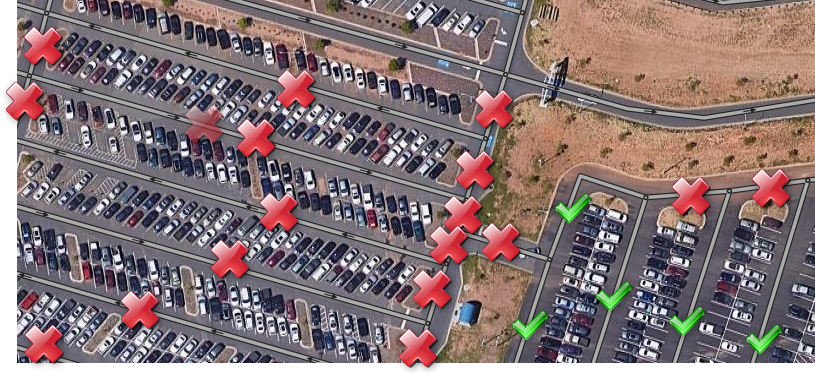
|
| PLR aisles with angled parking |
Parking Garages

Parking garages should not have each lane visible on the uppermost parking level mapped. Instead, each entry and exit road should be mapped as one-way or two-way as appropriate. As of October 2018[update], Parking Lot Areas (“PLA”) do not support multiple entries. For this reason, connect the entry and exit road segments to a single segment, with the PLA’s entry point set along that segment. This allows Waze to choose the best entry to the garage depending on the route’s starting location.
Small Parking Lots
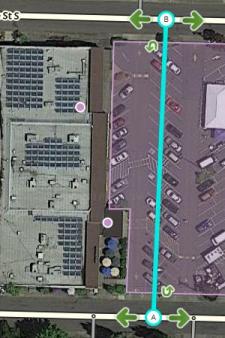
For small lots, if there is only one entrance and one exit, or if there are multiple entrances/exits near to each other on the same road, then it may not be necessary to add PLRs at all, especially if the entrances and exits are on a divided or one-way road (so there's effectively only one way in and one way out). Small parking lots should be mapped if:
- there are entrances/exits to the lot on more than one street;
- there are nearby PLRs that might cause a user to be snapped to the wrong lot;
- the Place served is a gas station or has a drive-thru.
If the small lot is on at the corner of two or more non-PLR roads, the value of the lot should be carefully weighed against the damage to (turn timing) done by adding nodes near an intersection. Consider if the addition of a Junction Box is needed to resolve data collection concerns.
If it is determined that PLRs are desirable in a small lot, then follow the same instructions as when mapping a large lot. However, in cases where a small store-front parking lot has a pair of one-way aisles, such as at a ‘strip mall’, it is acceptable to use a single two-way road segment that approximates the location of both aisles. In this case, enable the u-turns on either end of the segment, so users traveling in either aisle will get efficient routes.
Drive-Through Lots
Because drive-through lots can be narrow and congested, with one-way sections, the best way to represent them is often a one-way drive-through loop. Caveat: because both ends of a segment cannot connect to the same junction, if the lot has only one entrance/exit, it is necessary to build the loop using three segments.
Two parking lots connected to the same street
Bad routing can occur when two parking lots connect to the same street. This can happen, for example, where two lots face each other. If you connect both parking lots to the street using the same junction as the connection point for both, Waze will treat them as one parking lot.
If there are no turn restrictions preventing routing across the street, Waze may route the driver through one parking lot to reach a destination in the other parking lot. Waze is designed to avoid such routes, but in this configuration, Waze does not apply the expected penalty - because crossing through the junction from one parking lot segment to the other is not considered a transition, even though there is also a street running through the junction. This may be most easily understood by looking at the example image below.
If it is not legal to cross from one lot to the other, turn restrictions will prevent any sort of routing between the lots. However, if it is possible to route from one lot to the other, then a different method is required to prevent routing through one lot to reach the other.
To be sure that Waze will apply the transition penalty when routing through one parking lot from another, the two parking lots must be isolated from the each other such that passing from one to the other requires driving over a standard road segment (not a parking lot road or private road). You should use a short "stub" length no less than 19.69 ft (6 m) of a standard road segment. This segment will run from the junction to the entry/exit segment of one of the lots. With this configuration, exiting the parking lot will have a consistent penalty, whether the route exits the first parking lot to the street or the route leads to another parking lot at the same junction. The short stub may reduce display impact and will also signal other editors that the use of a different road type is not accidental.
Parking lots do not have to be across the street from each other. In a strip mall, if the exit segment of one business is joined to the entrance segment of the next business, the same problem can occur.
Illustration
For example, in the configuration shown below, if routing from the west parking lot, there is no transition penalty to route through the gas station parking lot on the east side of the street if routing east on Riva Rd. Conversely, if routing to the west parking lot from Riva Rd. there is no transition penalty to use the gas station.
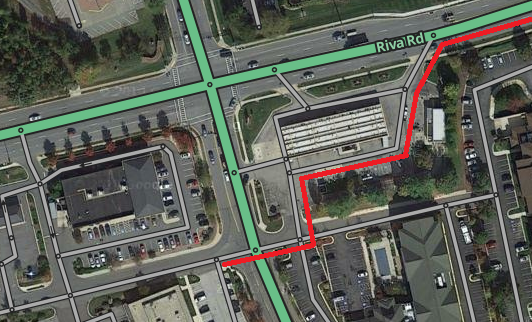

This potential problem arises when two parking lots on opposite sides of a street connect at the same junction node on the street.

If this configuration causes routing problems it can be solved by changing the road type of one (or both) of the parking lot roads that intersect with the street.

A 19.69 ft (6 m) or longer stub of a different road type will accomplish the same result.

If the street is a divided highway, then the road type of the crossover segment may be changed (this may also allow U-turns at the crossover segment).
New Roads
Recorded via Client
Once you start editing a road, it changes from red (a new road) to the color of a road type (by default a white street) and will then appear on the next update of the Live Map which goes out to all Waze users.
So it is less than helpful if you do an incomplete job. At least if the road is red, then someone else knows that it needs work. If it is white, perhaps even with a street name, then it may look correct. But Waze may not view it as navigable.
Follow these simple steps, as best you can, and get it right the first time. Map Editing explains how to carry out these steps.
- Align the geometry of the road to the aerial image unless that is not appropriate in your area
- Enter the correct name and road type for your road, following the standards for your country
- Make sure the road has the correct directionality. Most roads should be Two Way.
- Add junctions where the road intersects with other roads. By default tick "Enable all turns". Restrict any turns that are not allowed. If a junction appears, just add a junction over the top. Chances are it does not have all turns enabled. Waze automatically handles turn restrictions for one-way roads.
Roundabouts
- A proper roundabout (i.e., produces "at the roundabout..." verbal cues) can only be created in WME.
- When it is first created, the segments are configured as new roads - they need to be edited as above before they become part of the live map.
- Please see Creating and Editing a roundabout for more information on creating these special intersections.
